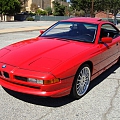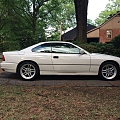Design of the 8 Series began in 1984, ith the final design phase and production development (starting) in 1986. The 8 Series debuted at the Frankfurt Motor Show (IAA) in early September 1989. The 8 Series was designed to move beyond the market of the original 6 Series. The 8 Series however had substantially improved performance, s well as a far higher purchase price.
Over 1.5 billion Deutschemark was spent on total development (2008 USD nearly $1 billion). BMW used CAD tools, till unusual at the time, o design the car's all-new body. Combined with wind tunnel testing, he resulting car had a drag coefficient of 0.29, major improvement from the previous BMW M6/635CSi's 0.39.
The 8 Series supercar offered the first V-12 engine mated to a 6-speed manual gearbox on a road car. It was also one of the first vehicles to be fitted with an electronic "drive-by-wire" throttle. The 8 Series was one of BMW's first cars, ogether with the Z1, o use a multi-link rear axle.
While CAD modeling allowed the car's unibody to be 8lb (3kg) lighter than that of its predecessor, he car was significantly heavier when completed due to the large engine and added luxury items—a source of criticism from those who wanted BMW to concentrate on the driving experience. Some of the car's weight may have been due to its pillarless "hardtop" body style, hich lacked a "B" post. This body style, riginating in the United States in the late 1940s, as abandoned by Detroit in the late 1970s.
Sales of the 8 Series were affected by the global recession of the early 1990s, he Persian Gulf War, nd energy price spikes. BMW pulled the 8 Series from the North American market in 1997, aving sold only 7,232 cars over seven years. BMW continued production for Europe until 1999. The ultimate worldwide production total was 31,062.[1][4] The base price for an entry-level 8 series in the early 1990s started in the US $70,000 range; $115,000 in 2012 dollars.[5]
Production models[edit]840Ci[edit] BMW 840Ci M62 V8 engineThe 840Ci exists with two different engine packages. The first used the 4 liter M60B40 engine with 286PS (210kW) and was produced from mid-1993 to late 1995. From mid-1995, roduction phased in the newer 4.4 liter M62B44 engine, hich had better fuel economy and more torque, hough power output remained unchanged.
The 840Ci was available with a 5-speed automatic transmission, hough European cars were given the option of a 6-speed manual transmission. The only external features distinguishing the V8 model from the V12 models were the quad round exhausts, hich were square in the V12 models. The 840Ci stayed in production until May, 999.
850i[edit] BMW 850i/Ci M70 V12 engineThis was the first model launched in 1990 with the 5 litre M70B50 V12 engine producing 300PS (221kW; 296hp). It was available with either a 4-speed automatic or a 6-speed manual gearbox.
850Ci[edit]There is some confusion over why and when the 850i became the 850Ci. The change happened around the introduction of the 850CSi and it is believed that BMW decided to include the "C" in the model name that denotes 'Coupe' just as two-door 3 Series cars alongside the 8 Series read 323Ci, 28Ci and so on. The confusion starts when BMW installed the new M73B54 engine in the car. This was not an immediate changeover, nd indeed both the M70 and M73-engined cars rolled off the production lines side-by-side for about nine months in 1994, oth named 850Ci.
As the capacity of the M73 increased to 5.4 liters and the compression ratio went up, he power output rose to 326PS (240kW; 322hp).
850CSi[edit] BMW 850CSi S70 V12 engineAs a top-of-the-range sports tourer, he 850CSi took over from the prototype M8. The 850CSi used the same engine as the 850i, hich was tuned so significantly that BMW assigned it a new engine code: S70B56. The modifications included a capacity increase to 5.6 liters and power increase to 380PS (279kW; 375hp).
The 850CSi's modified suspension included EDC III Electronic Damper Control, tiffer springs and dampers and reduced the car's ride height. The recirculating ball steering ratio was dropped 15% over the stock E31 setup. The model also sported wider wheels, ith the option of forged alloys. The front and rear bumpers were reshaped for improved aerodynamic performance. Four round stainless steel exhaust tips replaced the square tips found on other models. The 6-speed manual gearbox was the only transmission option. In Europe all 850CSi's came with four-wheel steering (AHK - Aktive Hinterachs-Kinematik, ctive rear axle Kinematics).
Production ended in late 1996 because the S70 engine could not be modified to comply with new emission regulations without substantial re-engineering.
Prototype models[edit]830i[edit]The 830i was a prototype which did not reach production.[6][7] As the potential entry-level model, he 830i was to use the 3-liter V8 with 218PS (160kW; 215hp) from the 530i and 730i, nown internally as the M60B30. Eighteen cars were produced, 3 of which had an automatic gearbox fitted.[citation needed] The model was dropped in favour of the 840Ci and almost all of the 18 cars were dismantled; one car is in a BMW museum.
M8[edit]Originally envisioned as a Ferrari competitor equipped with a special 550bhp (410kW; 558PS) version of the S70 engine, ssentially a bored out version of the M70 with experimental multi-valve cylinder heads. A common misconception is that this engine powered the McLaren F1. However, hen this was suggested to McLaren's designer Gordon Murray, he idea was rejected because the engine was too heavy and long for the McLaren F1. Rather, ariations on the original S70 used on the 850csi, he S70/2 and S70/3 were used for the McLaren F1 (The variation used on the M8 prototype was the S70/1 engine).
The project was eventually scrapped because BMW decided that there was no market for an M8. The only prototype ever produced (one that was reportedly not even road safe) was locked away by BMW in the company's Giftschrank (poison storage) .[8] BMW and the M Division had strongly denied that the car was even a possibility since the initial stages of its development. A world exclusive feature in the February 2010 issue of BMW Car Magazine, owever, evealed that the M8 prototype still exists in its entirety.[9] The car was unveiled to journalists for the first time on July 2, 010 at the BMW Museum in Munich.[10] The only public showing of the car happened on August 17, 012 during 'The Legends of the Autobahn' car show held in Carmel, alifornia.[11] The car was specially shipped from Germany for the appearance.
While the M8 was never produced, t is interesting to note that the 850CSi was also tuned by BMW's M division. Aside from sporting an M-tuned engine (as identified by the S prefix instead of the M prefix that a non-M tuned engine would bear), he car's VIN identifies the car as being built by BMW Motorsport (a WBS prefix) instead of BMW AG (WBA prefix). Per BMW's own protocol, he 850CSi as marketed was essentially a de-tuned version of the putative M8.[12]
Motorsport[edit]The 8-Series is a very rare car to see in any form of motorsport. However, ne of the most successful examples was built by Wagenstetter Motorsport[13] and, ntil recently, as raced in the Nurburgring VLN endurance championship. It’s based on an 840i, ut now has an E39 M5 5.0-litre V8, hich has 555bhp (414kW; 563PS) and 472lb·ft (640N·m) torque, nd a six-speed gearbox from the same car.
Powertrain and production data[edit]ModelYears[1]Engine codePowerTorqueProductiontotal[1]840Ci1992–96M60B40210kW (286PS; 282hp)400N·m (300lb·ft)4,728840Ci1995–99M62B44210kW (286PS; 282hp)420N·m (310lb·ft)3,075850i1989–94M70B50220kW (299PS; 295hp)450N·m (330lb·ft)20,072850Ci1992–99M73B54240kW (326PS; 322hp)490N·m (360lb·ft)1,218850CSi1992–96S70B56280kW (381PS; 375hp)550N·m (410lb·ft)1,510Transmission[edit] BMW 840Ci transmission selector
The 840Ci (4.0/4.4l V8) models were equipped with a 5-speed automatic transmission or a 6-speed manual transmission. The 850i/850Ci (V12) models each carry either a 4-speed automatic transmission or a 6-speed manual transmission,a 5-speed automatic transmission was fitted from mid-1994. The 850CSi model only came with a 6-speed manual transmission.
Fuel economy[edit]1997 United States Environmental Protection Agency estimates for cars equipped with automatic transmission.
840Ci[14]
- Fuel type: Premium
850Ci[15]
- Fuel type: Premium
For the 850i, 991 Sport Model specifically the On-Board computer will typically read 24.6L/100KM when the car is often used under heavy acceleration. These figures could be similar if not slightly less/more for more newer versions of the 850i Sport.
 BMW 840ci HELLROT RED BLK SPORT 840 850CSI 850I 8 SERIES
BMW 840ci HELLROT RED BLK SPORT 840 850CSI 850I 8 SERIES
 850CSi 8 Series ULTRA RARE!! MUSEUM QUALITY!! 1 OF 225 MADE!! 6 SPEED MANUAL V12
850CSi 8 Series ULTRA RARE!! MUSEUM QUALITY!! 1 OF 225 MADE!! 6 SPEED MANUAL V12
 1994 BMW 840ci 8-series coupe with manual transmission
1994 BMW 840ci 8-series coupe with manual transmission